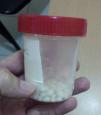Synovial osteochondromatosis was described in 1833 by Laennec.1 Its worldwide incidence is reported to be 1:100,0002 and it is found in a greater number of men than women. The joint most frequently affected is the knee.3 The clinical signs are nonspecific and the diagnosis requires imaging techniques.4 The treatment at the present time is surgical and consists of resection of the chondral bodies.5,6
Case ReportThe patient was a 29-year-old woman who had a 4-year history of pain in right shoulder, associated with limitation of vertical abduction and characterized by an indolent course. When she visited her physician, she had detected another pain in the anterior region of her shoulder. She underwent imaging studies (Figs. 1 and 2), and the diagnosis was synovial osteochondromatosis.
Radiographs of the shoulder in true anteroposterior (AP), external rotation (ER) and internal rotation (IR) positions revealed the presence of multiple calcified bodies of the same size, distributed throughout the entire glenohumeral joint, as well as the subscapularis recess and the bicipital groove.
Magnetic resonance imaging was employed to acquire turbo spin echo diffusion weighted (DW) sequences with fat saturation that effectively demonstrated the anatomy of the shoulder joint and the presence of loose bodies previously identified in radiographs and ultrasound images. They had a characteristic behavior, with areas of lower signal intensity in the center than in the periphery, because of the calcification of the chondral bodies.
Arthroscopic resection enabled the removal of chondral fragments, which were sent to the pathology laboratory for analysis. The result was a histopathological diagnosis of synovial chondromatosis (Fig. 3). The patient's postoperative course was satisfactory, and the pain disappeared.
DiscussionThe findings observed (loose chondral bodies, joint effusion and generalized inflammatory changes) are compatible with reports in the literature, although, in this case, the patient was a woman.3
Ethical DisclosuresProtection of human and animal subjectsThe authors declare that the procedures followed were in accordance with the regulations of the relevant clinical research ethics committee and with those of the Code of Ethics of the World Medical Association (Declaration of Helsinki).
Confidentiality of dataThe authors declare that they have followed the protocols of their work center on the publication of patient data.
Right to privacy and informed consentThe authors have obtained the written informed consent of the patients or subjects mentioned in the article. The corresponding author is in possession of this document.
Conflicts of InterestThe authors declare they have no conflicts of interest.
Please cite this article as: Díaz Fernández JF, Peraza Mc Liberty RA. Osteocondromatosis sinovial de hombro. Reporte de un caso y revisión de la literatura. Reumatol Clin. 2018;14:56–58.












